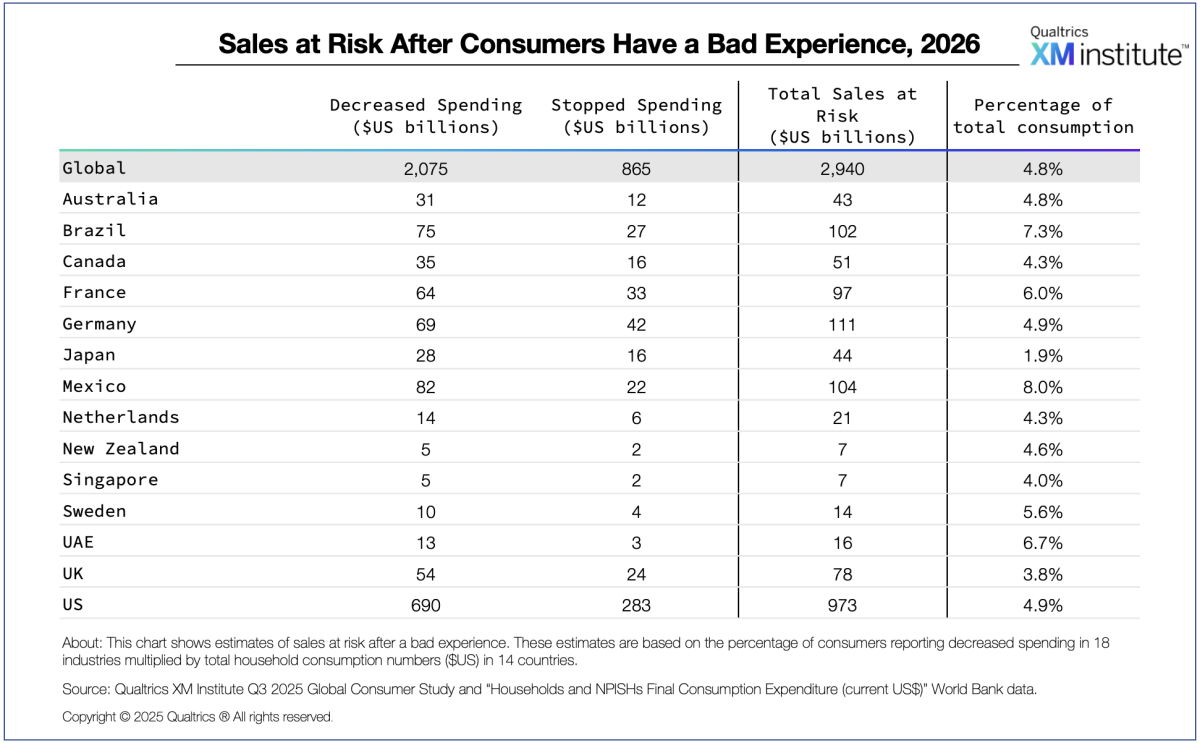Customers regularly encounter bad experiences; Qualtrics XM Institute’s Q3 2025 global consumer research of over 20,000 found that 11% of experiences globally are bad, and 47% of those bad experiences lead customers to cut spending. This allows us to calculate the total sales at risk due to poor experiences:
Sales at risk = % poor experiences x % poor experiences that result in cut spending
The Global Impact: $3 Trillion at Risk
Qualtrics XM Institute estimates that organizations globally are putting nearly $3 trillion of their sales at risk in 2026. Consumers will cut back from nearly $2.1 trillion of their spending and cease spending $865 billion entirely with organizations that deliver very poor customer experiences.

Based on our analysis, we found that:
- The rate of sales at risk is highest in Mexico. Mexican organizations stand to lose the greatest percentage of sales at risk due to poor experiences, at 8%. Japanese organizations have the lowest rate of sales at risk, at just 2%.
- The value of sales at risk is highest in the US. American organizations risk a total of $973 billion – nearly one trillion dollars – of sales by delivering bad customer experiences. Meanwhile, New Zealander organizations risk the least in total $USD, with just $6.6 billion at risk.
What’s Changed?
- Last year, we estimated that there were $3.8 trillion in sales at risk globally. So what’s changed? Compared to last year:
- Poor experiences are just as frequent. While the frequency of poor experiences fluctuates by industry, the percentage of poor experiences globally (11%) did not change significantly over the previous year.
- Consumers are less likely to cut spending after poor experiences. Consumers cut spending after 47% of bad experiences, down 8 points from last year. They most often cut spending after bad fast food (62%) and online retail (58%) experiences, and least often do so after bad public utility experiences.
- We adjusted our sampling strategy. This year, we included fewer countries (14) and industries (18) in our study. Although we increased the sample size from each country, the overall representativeness of our sample decreased.
Next Steps
Tomorrow’s successful organizations must navigate closing their portion of this $3 trillion gap in an environment of ongoing technological disruptions, shrinking competitive advantages, and growing market uncertainty. In this environment, organizations that elevate CX beyond a nice-to-have to a strategic priority will protect both their customer loyalty and existing revenue streams.
Here are a few actions you can take to enable your organization to make this shift:
- Frame CX investments as risk mitigation. Reference your organization’s portion of this $3 trillion impact when requesting resources from leaders to help them understand the financial impact of poor customer experiences and the potential competitive advantages for organizations that consistently meet customer expectations. Be prepared to track and translate the value of your program’s actions into the business metrics which are critical to continue securing buy-in and resources.
- Investigate the moments that matter to your customers. Our research found that globally, service delivery issues are the top-cited cause of bad experiences, but this pain point may not be most acute or frequent for your customers. Understand the interactions and touchpoints that have the greatest impact on your organization’s customer loyalty through a journey mapping exercise. Set up listening posts to understand the current state of the most important moments and journeys and then track the business impact of improvements over time.
- Evaluate your current CX capabilities. Use the CX Maturity Assessment to understand your organization’s current strengths, opportunities, and determine which capabilities you need to build first to successfully implement your CX vision.
- Build a roadmap to ensure ongoing improvements. With an understanding of the quality of your most important experiences and the maturity of your program capabilities, you have two essential inputs for creating a roadmap to focus your CX efforts on the experiences that will have the greatest impact on the business outcomes your organization cares about.
Methodology
To generate this analysis, we multiplied sales at risk percentages by each country’s total consumption in $USD, as determined by the latest reporting from the World Bank. Once we determine the sales at risk across 14 countries, we identified that these countries represent 57% of the world’s global household consumption. If we assume that sales at risk for the rest of the world is equivalent to that of our 14 countries, we find that $2.94 trillion is at risk due to poor experiences.



